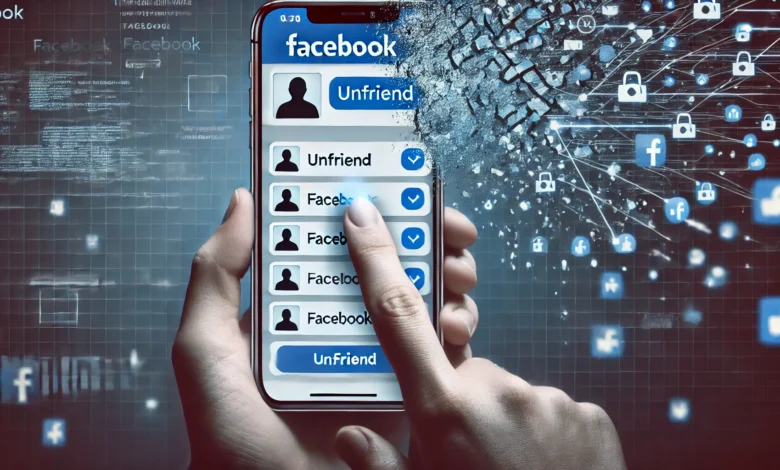Unfriend on Facebook: The Digital Act of Letting Go

Unfriend on Facebook, In the sprawling landscape of social media, few actions carry as much weight—or subtlety—as choosing to unfriend someone on Facebook. It’s a quiet click, a fleeting moment of decision, yet it can ripple through relationships, spark debates, and even redefine how we connect in the digital age. Since Facebook introduced the “unfriend” feature in 2004 alongside its launch, it’s become a cornerstone of online social dynamics, evolving from a niche tool to a cultural phenomenon. As of March 5, 2025, with Facebook still boasting over 3 billion monthly active users, the act of unfriending remains a fascinating lens into human behavior, technology, and the shifting boundaries of friendship. So, what does it mean to unfriend someone on Facebook? Why do we do it, and how has it shaped our digital lives?
The Birth of Unfriending: A Feature Takes Root
When Facebook debuted in 2004 as “TheFacebook” for college students, it was built around the idea of connection—friending was the core mechanic. But as networks grew, so did the need to prune them. The “unfriend” option emerged as a simple solution: a way to sever a digital tie without fanfare. Unlike blocking, which cuts all communication and visibility, or unfollowing, which mutes posts while preserving the connection, unfriending is decisive—it removes someone from your friends list entirely, often without notifying them.
By 2009, “unfriend” had gained enough traction to be named the New Oxford American Dictionary’s Word of the Year, beating out contenders like “sexting” and “birther.” Lexicographer Christine Lindberg described it as having “both currency and potential longevity,” a testament to its resonance in an era when social media was reshaping relationships. Back then, unfriending was still a novelty, often tied to petty spats or awkward encounters—like ditching a former roommate or an ex’s nosy cousin. Fast forward to 2025, and it’s a normalized, multifaceted act reflecting deeper societal trends.
Why We Unfriend: From Personal to Political
The reasons behind unfriending are as varied as Facebook’s user base. In the early days, it might have been a response to oversharing—think endless baby photos or cryptic status updates. But as the platform matured, so did the stakes. A 2018 study by the University of Colorado Denver found that political disagreements were a top driver of unfriending, a trend that exploded during the polarized 2016 U.S. election and persists into 2025. With algorithm-driven feeds amplifying divisive content, clashing views on climate change, vaccines, or global conflicts have turned friends lists into ideological battlegrounds.
Take the 2024 U.S. election cycle as an example. Posts on X in late 2024—like one from November 10 lamenting “just unfriended half my family on FB over politics”—echoed a familiar refrain. By early 2025, as tensions lingered, unfriending became a way to curate not just a feed but a worldview. Yet it’s not all about politics. Personal grudges still play a role: a friend who forgets your birthday, a coworker who humblebrags too much, or an ex whose new relationship photos sting. Then there’s the “Marie Kondo” approach—unfriending to declutter a digital life that’s grown unwieldy with hundreds or thousands of connections.
Mental health has also emerged as a motivator. A 2023 survey by the Pew Research Center found that 41% of social media users had unfriended or unfollowed someone to reduce stress or negativity, a statistic that likely held into 2025 as self-care remains a buzzword. Unfriending, in this sense, is less about rejection and more about boundaries—a way to say “no” in a world where “yes” is the default.
The Psychology of Unfriending
Unfriending might seem trivial—a button press and done—but it’s layered with emotional complexity. Psychologists argue it mirrors real-world relationship dynamics, amplified by the permanence of digital records. Dr. Pamela Rutledge, a media psychologist, noted in a 2024 interview with Psychology Today that unfriending can feel like “a small betrayal or a liberation, depending on who’s clicking.” For the unfriender, it’s often empowering, a reclaiming of agency. For the unfriended, if they notice, it can sting like a silent snub.
Facebook’s design adds intrigue: it doesn’t notify users when they’ve been unfriended, leaving discovery to chance—a mutual friend’s tag, a missing birthday alert, or a sudden inability to view a profile. This ambiguity can soften the blow or prolong the tension. Anecdotes on X from early 2025, like a January 15 post reading “found out my ex-BFF unfriended me after 3 years, ouch,” highlight the delayed sting of realization.
The act also raises questions of reciprocity. In real life, friendships fade organically; on Facebook, unfriending is unilateral, a power move that doesn’t require mutual consent. This asymmetry can amplify hurt feelings or, conversely, offer closure without confrontation. For introverts or conflict-avoiders, it’s a godsend—a way to exit without explanation.
Cultural Impact: Unfriending Goes Mainstream
Unfriending has transcended Facebook to become a cultural shorthand. TV shows like The Good Place and Black Mirror have woven it into plots about social exclusion, while memes about “unfriending IRL” abound. In 2025, it’s a verb that spans platforms—people talk of “unfriending” on Instagram or X, even if the mechanics differ (e.g., unfollowing or muting). It’s a symbol of the curated self, a rejection of the early internet’s “everyone’s connected” ethos in favor of intentional networks.
The COVID-19 pandemic accelerated this shift. As physical isolation drove social media use skyward in 2020-2021, friendships calcified online, and unfriending became a way to shed pre-pandemic ties that no longer fit. By 2025, with hybrid work and virtual hangouts normalized, the friends list is less a Rolodex and more a reflection of current relevance. Unfriending, then, is less dramatic than it once was—it’s routine maintenance.
Yet it’s not without controversy. Some decry it as petty or passive-aggressive, arguing that blocking or talking it out is more mature. Others defend it as a right to control one’s digital space. A 2024 thread on X debated whether unfriending over politics was “weak” or “self-respect,” with no consensus—proof that the act remains a lightning rod.
How to Unfriend: A Step-by-Step Guide
For the uninitiated, unfriending on Facebook is straightforward but worth detailing as of 2025’s interface:
- Navigate to Their Profile: Search for the person or find them in your friends list (under your profile’s “Friends” tab).
- Click the Friends Icon: Near their name, you’ll see a silhouette with a checkmark labeled “Friends.”
- Select Unfriend: From the dropdown, choose “Unfriend,” then confirm if prompted. They’re gone—no notification sent.
Post-unfriending, they can’t see your non-public posts or tag you, though mutual friends’ interactions might still overlap. If regret hits, you’ll need to send a new friend request—awkwardness optional.
The Alternatives: Beyond Unfriending
Facebook offers softer options. Unfollowing hides posts without cutting ties, perfect for that loud uncle. Restricting limits what they see without their knowledge—a stealth mode for frenemies. Blocking is the nuclear option, erasing all traces. Each serves a purpose, but unfriending strikes a unique balance: final yet discreet.
Unfriending in 2025: A Snapshot
As of March 5, 2025, unfriending remains a daily ritual for millions. Facebook’s user base, though plateauing in some regions, still dwarfs competitors, and its friends list feature keeps unfriending relevant. Younger users may lean toward Instagram or TikTok, but Facebook’s legacy as a “digital yearbook” for Millennials and Gen X ensures its staying power. A quick X search reveals fresh takes—like a February 28, 2025, post joking “unfriended my boss on FB, now I’m free”—showing it’s still a topic of humor and catharsis.
The Bigger Picture: Connection in Flux
Unfriending on Facebook is more than a button—it’s a microcosm of how we navigate relationships in 2025. It reflects a world where connections are abundant but disposable, where digital proximity doesn’t guarantee closeness. It’s a reminder that even in a platform built to unite, disconnection is just as vital. Whether it’s purging a toxic tie, dodging a debate, or simply moving on, unfriending empowers users to shape their online lives—one click at a time.
As social media evolves, unfriending may shift in form or fade in prominence, but its essence—choosing who belongs in our orbit—will endure. For now, it’s a quiet rebellion against the pressure to stay linked forever, a digital goodbye that needs no words.
Conclusion: The Lasting Echo of Unfriending
Unfriending on Facebook, as simple as a click, carries a profound weight in 2025. From its origins in 2004 to its cultural peak as a symbol of digital curation, it’s evolved into a tool for setting boundaries, dodging conflict, or reclaiming peace in an overcrowded online world. Whether driven by politics, personal rifts, or a quest for mental clarity, the act reflects our need to control who shares our digital space. As of March 5, 2025, with Facebook’s 3 billion users still navigating its ecosystem, unfriending remains a quiet yet powerful choice—less about rejection and more about agency. It’s a reminder that even in a platform designed to connect, disconnection is just as essential. As social media continues to shape how we relate, unfriending stands as a timeless gesture: a small, deliberate step toward a network that feels like ours.


